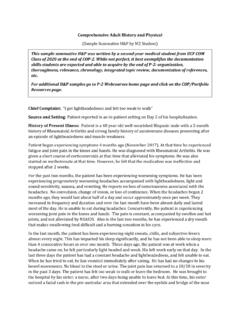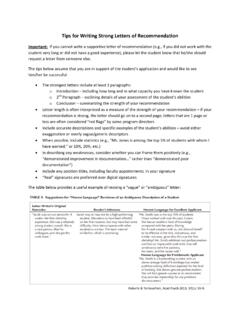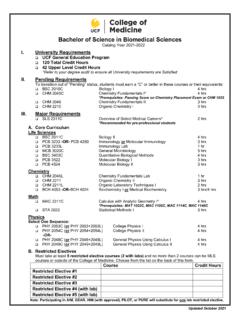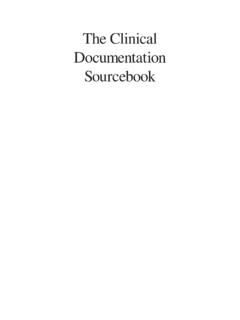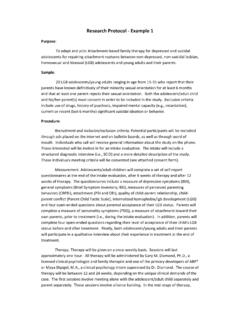Transcription of Guide to the Comprehensive Pediatric H&P Write Up
1 Guide to the Comprehensive Pediatric H&P Write Up INSTRUCTIONS FOR USE OF THE SECTION ON Pediatric HISTORY AND PHYSICAL EXAM The following outline for the Pediatric History and Physical Examination is Comprehensive and detailed. In order to assimilate the information most easily, it is suggested that you read through the whole section before examining your first patient to get a general idea of the scope of the Pediatric evaluation. Then, as you encounter patients with specific problems, you may return to the individual sections most pertinent to these patients to absorb the information in detail. Repeat practice with a variety of patients of different ages is crucial to the acquisition of skills in data collection. You should use every opportunity possible to evaluate patients in order to develop a sense of normal growth and development and appreciate the variations in patient encounter that is necessary to perform appropriate evaluation children of different ages.
2 OUTLINE FOR Pediatric HISTORY HISTORY I. Presenting Complaint (Informant/Reliability of informant) Patient's or parent's own brief account of the complaint and its duration. Use the words of the informant whenever possible. II. Present Illness Begin with statement that includes age, sex, color and duration of illness, ex.: This is the first APH admission for this 8 year old white male who has complained of headache for 12 hours PTA. When was the patient last entirely well? How and when did the disturbance start? Health immediately before the illness. Progress of disease; order and date of onset of new symptoms. Specific symptoms and physical signs that may have developed. Pertinent negative data obtained by direct questioning. Aggravating and alleviating factors.
3 Significant medical attention and medications given and over what period. Use day of admit (DOA) as the reference point for your timeline of present illness. Ever event/symptom that occurs leading up to DOA should listed as # day prior to admission (PTA) In acute infections, statement of type and degree of exposure and interval since exposure. For the well child , determine factors of significance and general condition since last visit. III. Past Medical History Birth A. Antenatal: Health of mother during pregnancy. Medical supervision, drugs, diet, infections such as rubella, etc., other illnesses, vomiting, toxemia, other complications; Rh typing and serology, pelvimetry, medications, x-ray procedure, maternal bleeding, mother's previous pregnancy history.
4 B. Natal: Duration of pregnancy, birth weight, kind and duration of labor, type of delivery, presentation, sedation and anesthesia (if known), state of infant at birth, resuscitation required, onset of respiration, first cry. C. Neonatal: APGAR score; color, cyanosis, pallor, jaundice, cry, twitchings, excessive mucus, paralysis, convulsions, fever, hemorrhage, congenital abnormalities, birth injury. Difficulty in sucking, rashes, excessive weight loss, feeding difficulties. You might discover a problem area by asking if baby went home from hospital with his mother. A common way to document birth history is as follows: 3445 g full term infant born to a 28 yo G2P2 O+ mother via normal spontaneous vaginal delivery after a pregnancy where mother received prenatal care in the first trimester whose prenatal labs were GBS-, HIV-, GC-, chlamydia -, RPR nonreactive.
5 Mom reports no medications taken during pregnancy or delivery. Delivery was uncomplicated. No resuscitation was required. APGARs were 8 at 1 min and 9 at 5 min. Nursery course was uncomplicated and infant went home with mom on DOL#2. Past Illnesses A comment should first be made relative to the child 's previous general health, and then the specific areas listed below should be explored. A. Past medical history: including all diagnoses, infections, Accidents and Injuries (include ingestions): Age, type/nature, severity, sequelae. B. Past Hospitalizations: including operations, age. Include place of hospitalization and duration of hospitalization. C. Past Surgeries: where and by whom for what diagnosis D. Allergies, with specific attention to drug allergies: detail type of reaction.
6 Results of allergy testing gif performed. E. Medications patient is currently taking- prescribed, OTC, homeopathic. Include dose, formulation, route and frequency. Immunizations and Tests Be familiar with Advisory Committee on Immunization Practices (ACIP) recommendations for immunizations. List date and type of immunization, facility providing immunization as well as any complications or reactions. DO NOT LIST Up to date per parent report If no immunization record is available, include this as a problem in the assessment and plan so it will be followed up. Growth and Development A. Development Motor and Mental Development First raised head, rolled over, sat alone, pulled up, walked with help, walked alone, talked (meaningful words; sentences), formal screening when appropriate.
7 Urinary continence during night; during day Control of feces. Comparison of development with that of siblings and parents. School grade, quality of work. Physical Growth including menarche and other pubertal developments Behavioral History Does child manifest any unusual behavior such as thumb sucking, excessive masturbation, severe and frequent temper tantrums, negativism, Sleep disturbances. Phobias. Pica (ingestions of substances other than food). Abnormal bowel habits, ex. - stool holding. Bed wetting (applicable only to child out of diapers). Nutrition A. Breast or Formula: Type, duration, major formula changes, time of weaning, difficulties. Be specific about how much milk or formula the baby receives. How does caretaker mix the formula?
8 B. Vitamin Supplements: Type, when started, amount, duration. C. "Solid" Foods: When introduced, how taken, types. D. Appetite: Food likes and dislikes idiosyncrasies or allergies, reaction of child to eating. An idea of child 's usual daily intake is important. IV. Family History - use family tree whenever possible A. Age and health of family members (parents, grandparents, siblings) B. Stillbirths, miscarriages, abortions; age at death and cause of death of immediate members of family C. Known genetic diseases D. Diseases with a genetic contribution: allergy, blood dyscrasias, mental or nervous diseases, diabetes, cardiovascular diseases, kidney disease, rheumatic fever, neoplastic diseases, congenital abnormalities, cancer, convulsive disorders, others E.
9 Health of contacts- ill exposures ( ) V. Social History A. Type of habitat. Age of habitat, number of people in home and relationship to patient B. Marital status of parents and involvement with child C. Parents employment D. child care or school VI. Environmental History A. Environmental tobacco smoke B. Water source to home C. Pets D. Smoke and CO detectors E. Firearms VII. System Review A system review will serve several purposes. It will often bring out symptoms or signs missed in collection of data about the present illness. It might direct the interviewer into questioning about other systems that have some indirect bearing on the present illness (ex. - eczema in a child with asthma). Finally, it serves as a screening device for uncovering symptoms, past or present, which were omitted in the earlier part of the interview.
10 There is no need to repeat previously recorded information in writing a Review of Systems. Questions about health maintenance may be included here such as last dental visit, last ophthalmology A. General: Unusual weight gain or loss, fatigue, temperature sensitivity, mentality. Pattern of growth (record previous heights and weights on appropriate graphs). Time and pattern of pubescence. B. Eyes: Have the child 's eyes ever been crossed? Any foreign body or infection, glasses for any reason. C. Ears, Nose and Throat: Frequent colds, sore throat, sneezing, stuffy nose, discharge, post-nasal drip, mouth breathing, snoring, otitis, hearing, adenitis. D. Teeth: Age of eruption of deciduous and permanent; number at one year; comparison with siblings.



